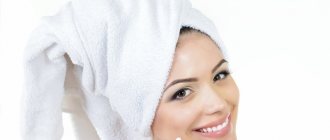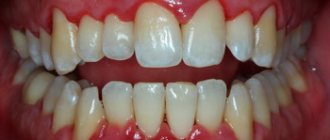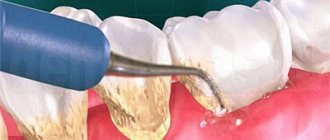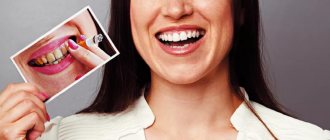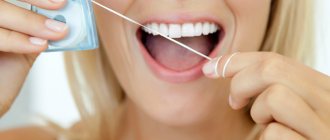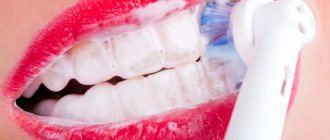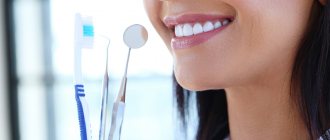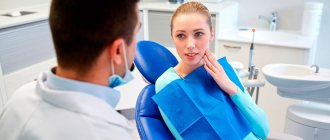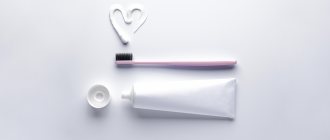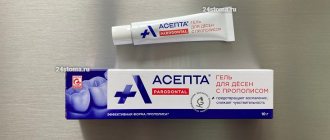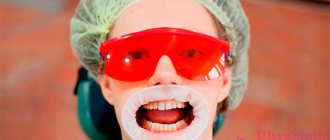Date of publication: 09/29/2018
Plaque is the worst enemy to oral health. It is he, or rather, the microbes that develop in him, that provoke the development of caries. The soft plaque becomes hard over time, turning into tartar.
It is the leading cause of gingivitis, periodontitis, gum pockets, and even tooth loss.
Plaque removal is necessary to keep teeth and gums healthy.
Why does plaque appear?
Soft plaque on teeth is normal. Its formation is associated not only with food intake, but also with natural processes in the oral cavity and the characteristics of the microflora. Food debris and various bacteria attach to the natural thin layer of plaque. If this layer is regularly cleaned, it does not cause any harm and is an integral part of the body's functioning.
Soft plaque can be deposited on teeth for a number of reasons:
- Insufficient oral hygiene.
- Lack of solid food that can mechanically clean teeth when chewed.
- Malocclusion, crowded teeth. For this reason, it is impossible to remove plaque in some places with a toothbrush.
- A metabolic disorder that provokes changes in the microflora of the oral cavity and accelerated plaque formation.
- Taking certain medications.
- Periodontitis and other inflammatory processes.
Hard plaque, or tartar, forms when soft plaque is not cleaned thoroughly enough. Mineralization is responsible for this process, turning soft deposits into stone.
Standard method of brushing teeth Pakhomova G.N.
This method is recommended by most Russian dentists. It was invented by G.N. Pakhomov - professor of dentistry.
- Cleaning begins from the upper jaw in the following order - from the right molars to the front ones, then finishes on the left molars.
- On the lower jaw, the left major ones are cleaned first, then the anterior ones, and lastly the right molars.
- The front and back surfaces are cleaned with sweeping movements from bottom to top, with the brush head at an angle of 45° to the gum.
- It is important to make 10 movements for each tooth.
- Contaminants from the chewing side are removed by moving the head back and forth.
- To clean the front teeth, the brush is placed vertically and moved in a sweeping motion.
The Pakhomov method helps to effectively clean the oral cavity, but for the interdental spaces additional means are needed - irrigators, threads and a tongue scraper.
Why is dental plaque dangerous?
Bacteria attached to the surface of the teeth produce acids as a result of their vital activity. These substances have a detrimental effect on the enamel, causing its damage and further development of caries. Hard deposits also affect soft tissues, as they are located mainly in the cervical area and provoke inflammation of the gums. If the situation is not corrected, gingivitis and deeper forms of gum inflammation develop over time.
How to properly brush your teeth with toothpicks?
Doctors do not recommend frequent use of toothpicks, as they can injure the gums. However, if you don’t have floss on hand, you can carefully use a toothpick, following these recommendations:
- Do not use force when cleaning the interdental space from food particles;
- Do not make sudden movements;
- Try to maintain a 45-degree angle when using a toothpick;
- The direction of movement should be from the gum to the sharp edge of the tooth;
- It is recommended to apply only light pressure so that the toothpick does not break during the process.
Online consultation with a doctor
If you are concerned about the condition of your teeth, changes in enamel color, local or over the entire surface. Do you want to learn about ways to remove plaque and whiten your teeth? It is best to undergo an examination and consultation with a dentist. Because exciting symptoms may not just be a sign of plaque, but the beginning of the process of formation of tartar, diseases of a deeper nature. If you do not act on time, complications may arise: the formation of gum pockets that cause discomfort and require attention, gingivitis, periodontitis, inflammation of soft and hard tissues. Inaction will lead to the necessary more expensive treatment and work to save the tooth. Otherwise:
- depulpation, restoration;
- implantation;
- prosthetics;
- treatment of adentia.
Daily cleaning rules
Teeth should be brushed 2 times a day. Morning cleansing should be done before meals, and evening cleansing should be done after. It is not recommended to carry out this procedure more than 2 times to avoid abrasion of tooth enamel. After each meal, you can use a rinse or floss.
The recommended duration of the oral hygiene procedure is 3-5 minutes. During a given period of time, a person manages to make the optimal number of cleaning movements, sufficient to completely get rid of food debris, accumulated plaque and microorganisms.
How to remove plaque at home
There are several options for home cleaning of teeth from soft plaque:
- Thorough brushing with a toothbrush and toothpaste.
- Using dental floss, special brushes and brushes (this is especially important when wearing braces, crowns and other orthopedic structures in the mouth).
- Rinse with special solutions.
- Using an irrigator.
- Chewing gum (especially important if it is not possible to rinse your mouth after eating).
Tartar removal is a less simple procedure. These deposits are removed less readily and require softening. There are several ways to deal with solid deposits yourself:
- A solution of honey will help soften the put on. You need to rinse your mouth twice a day. Once softened, plaque can be removed with regular tooth brushing.
- A paste of boiled walnut branch bark is also used. You need to brush your teeth with it every day for a month.
- Lemon juice helps soften the stones. Use a swab dipped in juice to wipe your teeth until results are achieved.
- Once a week, it is recommended to brush your teeth with a mixture of baking soda and hydrogen peroxide (3% solution).
- Special rinses are effective. They contain components that stop the mineralization of soft plaque, destroy microbes, and relieve gum inflammation.
It is important to remember that the use of all of these products does not replace regular teeth brushing.
Tartar should never be removed mechanically. This may damage the enamel. Hard deposits located in hard-to-reach places can only be removed with professional cleaning.
Complex treatment: professional cleaning and strengthening of enamel!
Ultrasound removal of plaque and tartar + AirFlow whitening + enamel strengthening with gel and polishing - RUB 5,000.
More details
What to do to avoid the formation of tartar on your teeth
Take preventive measures:
- do not forget to brush your teeth thoroughly in the morning and evening
- purchase quality household hygiene products
- Don’t limit yourself to just one toothbrush: use flosses, irrigators, rinses
- avoid frequent snacking, balance your diet
- after eating, rinse your mouth with water
- less soft, high-calorie food, more solid and healthy food
- watch your health
- Visit your dentist and hygienist regularly
These simple tips will allow you to eliminate the first signs of dental plaque in time and reduce the risks of developing caries and periodontitis, which will be more difficult and expensive to treat.
Come to the Center for Modern Dentistry. Our specialists will teach you home hygiene techniques, tell you which brush and paste you need to use, and completely remove stubborn plaque in an effective and affordable way without harm to your health.
Your feedback
simpladent.com I chose the clinic based on reviews from friends.
And the doctor according to the principle “please, in the very near future.” I had experience with unsuccessful prosthetics, so, of course, I was in a state of great excitement. Then, when Sidorov D.A., Malinovsky I.Yu. started working with me. and Stotik V.V., I calmed down. Many kind words can be said about each of them. Now I have such natural teeth, which, by the way, chew perfectly and which I began to feel like my own. Thank you, Masters! Marina Borisovna |
10/13/2019 Leave a review Other reviews
Basic oral hygiene products
The main means of oral hygiene primarily include toothbrushes, the varieties and configuration of which we will consider below:
Toothbrushes
There are two types of these devices: conventional (manual) and electric. Regardless of what type of toothbrush it is, one of the main criteria for choosing it is the bristles.
Bristles by degree of hardness
- Hard (super hard). It is used strictly on the recommendation of a dentist and is especially suitable for people susceptible to excessive tartar formation. In addition, stiff bristles may be suitable for cleaning dentures;
- Medium hardness. It is considered a classic option, suitable for almost everyone without any restrictions. It is also well suited for the care of orthodontic structures and dentures;
- Soft. Recommended for use by children, as well as people suffering from bleeding gums and increased sensitivity of tooth enamel;
- Super soft. The use of such toothbrushes may be recommended by the attending physician based on the individual characteristics of the patient.
The bristles of toothbrushes are
- Natural. Made from animal guard hair. The main disadvantage of such bristles is their rapid wear and tear;
- Synthetic. Made from safe synthetic materials. It is distinguished by its long-term preservation of its qualities and ease of processing, guaranteeing the removal of contaminants after use.
In addition to the above, it is worth paying attention to the configuration of the bristles:
- Beveled with a slope. Allows you to most thoroughly remove plaque, including from the distant molars;
- Multi-level bristles. Allows you to remove food particles and plaque not only from the surface of the teeth, but also from the interdental crevices;
- Collected in bunches. Allows you to increase the coverage area, which also includes the necks of the teeth.
In addition to the main selection criteria listed above, it is also worth paying attention to the size of the cleaning head and its mobility. Movable heads are suitable for people who should avoid excessive pressure on teeth, gums, or orthodontic structures installed in the oral cavity to avoid damage.
Choosing an Electric Toothbrush
In addition to the main criterion, which is bristles, when choosing an electric toothbrush, you need to pay attention to:
- The shape of the cleaning head. They are round and elongated;
- Ability to change speed modes;
- Possibility of changing the direction of rotation;
- Mode type: ultrasonic, sonic, or ionization.
It is worth noting that it is advisable to use an electric toothbrush only after prior consultation with a dentist, who will help you choose the most suitable option.
Regardless of the type of toothbrush, replacement with a new one is carried out no later than 3 months from the start of use. Manual brushes must be completely replaced, and for electric brushes, the cleaning attachment must be replaced.
Toothpastes
All toothpastes are divided into three main groups:
- Hygienic. Designed for everyday oral hygiene;
- Therapeutic and prophylactic. The composition of such pastes includes components,
- Specialized. The use of this type of toothpaste is prescribed by the attending physician and is necessary to maintain the therapeutic effect achieved by the main treatment. The composition of such pastes includes medicinal components;
- Whitening. Pastes with a whitening effect contain abrasive particles and can whiten enamel by 1-1.5 tones. However, long-term use of whitening toothpastes is not recommended due to the risk of enamel damage.
Having a preventive and not pronounced therapeutic effect. As a rule, herbal preparations or formulations enriched with fluorine and calcium are used as specialized additives;
Irrigator Waterpik (Waterpik) –
Waterpick irrigators are developed (USA) and it is one of the most famous brands of irrigators in the world. However, the assembly of the devices is carried out in China. The manufacturer offers a fairly wide range of stationary models, but they all have similar characteristics. The characteristic of the water jet is a monojet with 1400 pulsations per minute, the water pressure is adjustable from 70 to 550-690 kPa (depending on the model). Unfortunately, microbubble technology is not used in Waterpik irrigators.
The flagship model is the Waterpik WP-100 EU Ultra irrigator, the price of which will be about 6,500 rubles. The most expensive model “Waterpik WP-660 EU Ultra Professional” will cost about 8,000 rubles (this model is distinguished by the presence of a second “gum massage” mode, as well as a wider selection of water pressure levels). The model that has the minimum cost is “Waterpik WP-70 EU Classic” from 4,500 rubles, which has fewer nozzles included + only 5 levels of water pressure adjustment.
Examples of Waterpik irrigators and attachments for them -
Let me summarize the pros and cons of Waterpik - 1) these are high-quality devices whose water pressure corresponds to the declared one, 2) a 2-year guarantee, which also confirms the reliability of these devices, 3) a very wide range of attachments for all cases - including periodontal ones for the care of gum pockets, attachment for braces, attachment for bridges, etc.
Disadvantages - the lack of microbubble technology, as well as the lack of a network of service centers in Russia (i.e. if a breakdown occurs during the warranty period, you will have to send the irrigator to Moscow at your own expense, and after some time they will simply send you a new device) . If the breakdown occurs after the expiration of the warranty period, then service is not possible and you will only have to throw away your device, because Apart from replacing attachments and batteries, the devices cannot be repaired.
History of the irrigator
This invention can be considered relatively new. It was first introduced about 60 years ago - in the early 1960s. The development of the instrument was carried out by an experienced dentist from the USA in a small town in the west of the country. He was also an engineer, so he had the opportunity to combine his knowledge in both areas and apply it in practice. Since then, the device has been tested many times, experiments and various studies have been carried out on it, which have proven the effectiveness and positive effect of the Waterpick teeth washing apparatus.
After some time, irrigators for washing teeth began to be produced not only in America, but also in other countries, including Russia. The leader in this area is the American manufacturer Waterpik, which boasts not only a wide range of models with various functions, but also a long warranty, quality materials, high build quality and durability. The company began collecting dental appliances back in the last century and currently offers a wide range of models.
